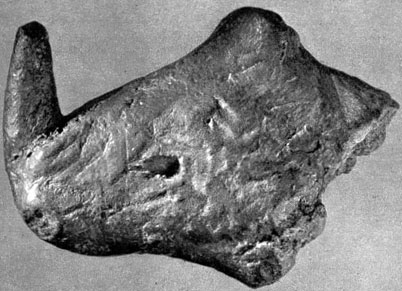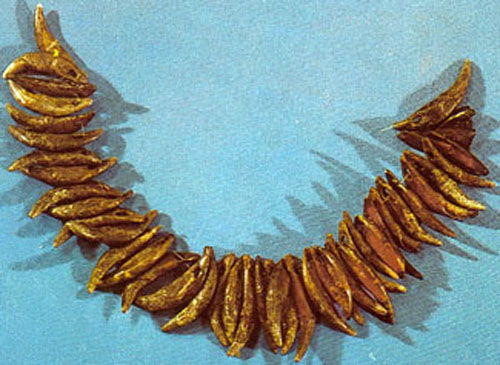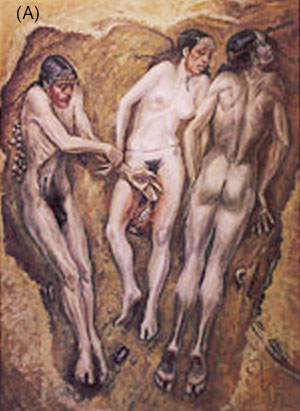An unusual burial tableau may provide insight into the same-sex relationships of ancient Cro-Magnon peoples
Queer history in Europe begins around the year 25,640 B.C. At that time, human evolution was just "coming of age" - what had been a monotonous, global culture began to explode with rapid new advances in creativity and diversity - knives, sewing needles, fired ceramics, fish-hooks, lamps, textile weaving, rope-making, complex hearths and habitations - all appeared around this time, in what scientists call the Gravettian era. Europe was then in the midst of an ice age (the average daytime temperature in the "summers" of this ice age was probably around freezing), yet in a small valley in Moravia in the modern Czech Republic, now called Dolní Vestonice, a small group of Cro-Magnon which never exceeded perhaps 100 individuals managed to survive and thrive in this harsh climate for several thousand years. This particular group not only pioneered the first clay ceramics and kilns ever discovered, but they also had a highly developed social order, which allowed a unique and rather bizarre drama to unfold within its small circle.



[Fired ceramic heads of a rhino and a lioness found at Dolni Vestonice, and the reconstructed kiln used]
In 1986, archaeologists working in Dolní Vestonice came across three skeletons in one common burial, which in itself is not all that unusual. But nothing like this triple burial has ever been found, for the 28,000 year old burial itself is in fact a tableau mort in which the corpses were deliberately arranged by this community to tell an enigmatic and fascinating story. The three men in this shallow grave were all about 18-20 years of age at the time of death - the two outer bodies were certainly robust young men - but most experts feel that the body in the center is of undetermined sex, although probably a tall but light-boned male or perhaps an intersexed person. Because of a severe congenital disability, the hips (which usually tell us the biological sex of an individual) are malformed and of indeterminate sex. However pelvic-bone expert Dr. Karen Rosenberg of the University of Vermont has claimed with certainty that, based on her examination of the pelvic area of the central body, it is indeed a young male. In an e-mail that Dr. Rosenberg sent to me on September 7, 2000, she wrote,
"My work showed that all three are indeed male (and fairly young males at that). The one in the center is a little problematic (my friend and colleague Vladimir Novotny called it 'enigmatic' and I think he used the term 'intersexed'). This seems to come from a developmental pathology (a growth disorder of some sort). I think that Erik Trinkaus may have come up with a precise diagnosis of it, but I can't remember right now what it was. Certainly that individual was short, with some unusual proprtions and quite a bit of left/right asymmetry especially in the legs."
The young man in the center certainly lived in a lot of pain and was probably unable to walk well as his thigh bones were fused into his hip socket.


[Two views of the three young men buried together, clearly showing the sexual nature of the tableau, taken from http://www.geocities.com/Athens/6293/series/bk4moravia.htm ;
note that the upper photo shows the now-burnt stake protruding from the groin of the man on the left (aka "Bruce")]
CLICK HERE FOR A CLEAR SKETCH OF THE BURIAL SITE
The disabled young man in the center was buried first, then the young man on the right was laid down on top of him face down (which is entirely unique in burial practice as far as I know - we almost always bury our dead on their backs or on their sides, as if sleeping), and their arms were entwined intimately. However, the skull of the man on the right is turned away from his companion in the center, as if in shame. Found near the neck of the young man on the right were many wolf teeth, probably the remnants of a necklace he wore (and for this I call him Lobo). The central individual is looking at Lobo, his forehead covered with red ocher (a form of iron oxide, or more simply rust; transhistorically and cross-culturally a symbol of blood, life, and rebirth), and he had apparently been wearing a necklace of Arctic fox teeth (and thus I call him Wiley, after the wiliness of the fox).

[Necklace of red arctic fox teeth found at Dolni Vestonice, photo by J. Jelinek, 'The Evolution of Man']
There is evidence that the young man on the left was still alive when he was placed into the grave site, impaled through the groin with a stake, and left to die. Once his body had gone beyond rigor mortis, the community arranged him so that he is looking down at the crotch of Wiley, and in fact both his hands are reaching into Wiley's pubic area. He also has red ocher all over his head and face (some think he was wearing a mask that had been painted with red ocher), and was wearing a necklace of human teeth. I call him Bruce.
Wiley in the middle also seems to have had a statue or some other carving or ceramic item made of red ocher placed in his groin or even inserted into his rectum, which has long since dissolved into crumbs. This could have been a red ocher dildo, a statuette of the Mother Goddess, a phallic baton, or some other ritual object, multiple examples of all these being found scattered in the hills of the Dolní Vestonice area.
While the sex of Wiley is noted by nearly every scholar as indeterminate or "enigmatic", all but Timothy Taylor have assigned a female gender to Wiley and then interpreted the grave tableau heterosexually (although Jean Auel, who used this as a pivotal scenario in The Plains of Passage from her "Earth's Children" series, leaves the gender of the middle person ambiguous); the scene is often described as that of "a young queen and two consorts", or a woman who died in childbirth, so her husband and the shaman who tried to save her were both killed. James Shreeves interprets the tableau heterosexually at length but then some 20 pages later makes the rather glib statement that "as fodder for romance, the burial has actually lost ground" in recent years because scholars now believe Wiley to have been male. Tellingly, Shreeves does not then reinterpret the burial scenario in this new light.


[Graphic A: artist's reconstruction of the Dolní Vestonice triple burial, erroneously depicting the middle person as a woman and failing to show the stake through the groin of "Bruce" on the left, taken from the cover of the German book "The Mammoth Hunters of Dolní Vestonice" - http://www.baselland.ch/docs/kultur/archaeologie/Pages/Publikationen/022.html;
Graphic B: my computer-generated reconstruction of the middle person as a man, and with the stake impaling "Bruce", sexualizing the scenario even more.]
A far more likely interpretation is that this burial tableau is a story of a same-sex relationship gone horribly wrong. It seems likely to me that Wiley and Lobo were lovers. [The wolf in later European tradition being symbolic of a sexual aggressor, or "top", even shows up in the tale of Little Red Riding Hood - a symbol of the hymen being consumed by the phallus dentatus. In addition, the fox has a long association in Europe with passive homosexuals because of its anthropomorphic wiliness, beguiling "smile", and liminal character who is neither fully wild nor fully domesticated. We will meet several other "foxes" in later columns.] Did Bruce (with his necklace of human teeth signifying a "man eater"?) rape, seduce, or even castrate Wiley, which so humiliated Wiley that he committed suicide, and in turn Wiley's lover, Lobo, killed himself in sorrow at the loss of his lover? Did the Dolní Vestonice community then execute Bruce in the grave of Lobo and Wiley as an eternal reminder of the consequences of this human tragedy?
Whatever our interpretation, this tableau tells us that very early in human history, complex sexual mores and taboos were firmly in place (prohibiting infidelity, or rape, or castration, but apparently not homosexuality - in fact this community seems to have valued this young male couple so profoundly as to ensure that their story be understood even millenia afterwards); and transgression of those communal rules brought about punishment in this emerging human sexual culture. This unique burial tableau also serves as a reminder that scientific "objectivity" is erroneous, and that heterosexism still prevails in the scientific community (giving us an inaccurate and skewed view of the human past).
For more information on this fascinating burial, see Timothy Taylor's The Prehistory of Sex: Four Million Years of Human Sexual Culture, and James Shreeves' The Neandertal Enigma: Solving the Mystery of Modern Human Origins.